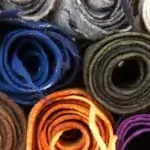Introduction
Wollmatten, or wool mats, are becoming increasingly popular for their versatility and sustainability. These mats, made from sheep wool, serve multiple purposes, making them an eco-friendly option for everything from home decor to agricultural practices. In this article, we’ll explore the various ways Wollmatten is being utilized today and why it could be the sustainable solution you’ve been seeking.
What Are Wollmatten?
Simply put, Wollmatten are mats made from natural sheep wool. Wool has been used for centuries for various purposes – from clothing to insulation – and Wollmatten takes advantage of this material’s natural properties in a new, modern way. The mats are typically made by compressing wool fibers together to form a durable, insulating material. The benefits? Wool is breathable, regulates temperature, and absorbs moisture, making it perfect for a wide range of applications.
Uses of Wollmatten
1. Home and Interior Design
Wollmatten are often used in homes for their aesthetic appeal and practicality. Unlike synthetic mats, wool mats bring a natural, textured look to a room. They come in various colors and styles, making them suitable for any home decor theme – whether modern, rustic, or something in between.
One of the main benefits of using Wollmatten in your home is its insulating properties. They help maintain a comfortable temperature by trapping warmth in winter and keeping rooms cooler in summer. Wool also absorbs moisture from the air, which helps regulate humidity levels. So, not only are you adding a beautiful decorative piece to your home, but you’re also enhancing its comfort and energy efficiency. These mats can be used in any room, whether it’s the living room, bedroom, or even the bathroom.
2. Agricultural Benefits
Beyond home decor, Wollmatten are also used in agriculture, where they serve several essential functions. In farming, these mats help with moisture retention and weed suppression. Because wool is natural and breathable, it helps keep the soil beneath the mat moist while also allowing it to breathe. This helps crops grow more efficiently, especially in drier conditions.
In addition to moisture control, Wollmatten serves as a natural method for suppressing weeds. By blocking sunlight, the mats prevent weed growth without the need for harsh chemicals or pesticides. This is particularly beneficial for organic farmers looking for sustainable solutions that minimize their environmental impact. Plus, once the wool mat is no longer needed, it decomposes naturally, which is far better than plastic alternatives that sit in landfills for centuries.
3. Architectural and Commercial Uses
Wollmatten are also finding their way into architecture and commercial spaces. One of the key reasons for this is their insulation properties. Wool is an excellent natural insulator, meaning Wollmatten can be used as part of a building’s insulation system. These mats help maintain a comfortable indoor climate by reducing heat loss during the winter and blocking excess heat during the summer. This is especially beneficial in energy-efficient building designs, where reducing the need for heating and cooling can drastically lower energy bills.
In addition to their insulation benefits, Wollmatten is also used as a soundproofing material. Their dense, fibrous structure makes them effective at dampening sound, making them ideal for commercial spaces like offices or hotels where noise reduction is essential. They help improve the overall acoustic environment of a room, making it more pleasant and quieter.
4. Other Applications
Aside from agriculture, interior design, and architecture, Wollmatten is also being used in other innovative ways. For instance, in the automotive industry, they are used for insulation purposes in car interiors. Their natural properties make them ideal for reducing noise and maintaining a consistent temperature inside vehicles. They are also being used in certain types of flooring systems, where their ability to absorb moisture and regulate temperature makes them an excellent choice for both residential and commercial buildings.
Comparison with Competitors
When comparing Wollmatten to other materials like synthetic mats, plastic weed barriers, or foam insulation, the advantages are clear. For one, Wollmatten are biodegradable. Unlike synthetic materials, which can take hundreds of years to decompose, Wollmatten break down naturally, reducing waste and helping to preserve the environment.
In terms of durability, while Wollmatten may not last as long as plastic mats, they still offer a good lifespan, mainly when used in the right conditions. Plus, they have the added benefit of being renewable and non-toxic, which makes them a safer choice for both the environment and people. Synthetic mats, on the other hand, are often made from non-renewable resources and can release harmful chemicals as they break down.
Wollmatten also outperformed competitors in terms of temperature regulation. Their natural fibers can absorb moisture, keeping things dry and comfortable. Synthetic mats, in contrast, often trap moisture or fail to provide the same level of airflow. This can lead to mold and mildew buildup in humid environments.
FAQs About Wollmatten
1. Are Wollmatten easy to clean?
Yes, Wollmatten are relatively easy to clean. Wool naturally resists dirt and stains, which means you don’t have to clean them as often as synthetic mats. However, if they do get dirty, most Wollmatten can be spot cleaned or vacuumed. For deep cleaning, it’s best to check the manufacturer’s guidelines.
2. How long do Wollmatten last?
The lifespan of a Wollmatte depends on the material’s quality and its usage. In general, these mats can last several years when well-maintained. However, they are biodegradable, so they will eventually break down over time. This is one of the advantages of using Wollmatten – when they reach the end of their life, they won’t contribute to long-term waste.
3. Are Wollmatten suitable for allergy sufferers?
Wollmatten can be a good option for people with allergies. Wool naturally repels dust mites and other allergens, making it a better choice than synthetic alternatives. Additionally, because wool is breathable, it helps to maintain good air quality in the home.
4. Can Wollmatten be used outdoors?
Yes, Wollmatten can be used outdoors, particularly in agricultural settings or as part of a landscaping project. They are durable enough to withstand outdoor conditions. Still, it’s essential to check with the manufacturer to ensure the mats are treated for outdoor use, as some versions might be better suited for indoor environments.
Conclusion
Wollmatten is a versatile, sustainable material with a wide range of uses. Whether you’re looking to improve the comfort and efficiency of your home, reduce your environmental impact in farming, or enhance the insulation and acoustics in commercial spaces, these wool mats have something to offer. They provide natural insulation, moisture control, and weed suppression without the need for harmful chemicals or plastics. Plus, they’re biodegradable and provide a natural alternative to synthetic materials, making them an excellent choice for eco-conscious consumers.

